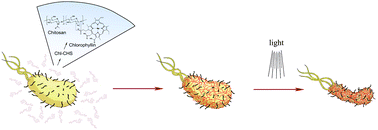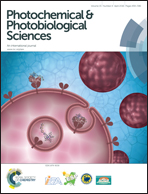Effective photosensitization-based inactivation of Gram (−) food pathogens and molds using the chlorophyllin–chitosan complex: towards photoactive edible coatings to preserve strawberries
Abstract
This study is focused on the novel approaches to enhance the inactivation of the Gram (−) food pathogen Salmonella enterica and harmful molds in vitro and on the surface of strawberries using the chlorophyllin–chitosan complex. Salmonella enterica (∼1 × 107 CFU mL−1) was incubated with chlorophyllin 1.5 × 10−5 M (Chl, food additive), chitosan 0.1% (CHS, food supplement) or the chlorophyllin–chitosan complex (1.5 × 10−5 M Chl–0.1% CHS) and illuminated with visible light (λ = 405 nm, light dose 38 J cm−2) in vitro. Chlorophyllin (Chl)-based photosensitization inactivated Salmonella just by 1.8 log. Chitosan (CHS) alone incubated for 2 h with Salmonella reduced viability 2.15 log, whereas photoactivated Chl–CHS diminished bacterial viability by 7 log. SEM images indicate that the Chl–CHS complex under these experimental conditions covered the entire bacterial surface. Significant cell membrane disintegration was the main lethal injury induced in Gram (−) bacteria by this treatment. Analysis of strawberry decontamination from surface-inoculated Salmonella indicated that photoactivated Chl–CHS (1.5 × 10−5 M Chl–0.1% CHS, 30 min incubation, light dose 38 J cm−2) coatings diminished the pathogen population on the surface of strawberries by 2.2 log. Decontamination of strawberries from naturally distributed yeasts/molds revealed that chitosan alone reduced the population of yeasts/molds just by 0.4 log, Chl-based photosensitization just by 0.9 log, whereas photoactivated Chl–CHS coatings reduced yeasts/molds on the surface of strawberries by 1.4 log. Electron paramagnetic resonance spectroscopy confirmed that no additional photosensitization-induced free radicals have been found in the strawberry matrix. Visual quality (color, texture) of the treated strawberries was not affected either. In conclusion, photoactive Chl–CHS exhibited strong antimicrobial action against more resistant to photosensitization Gram (−) Salmonella enterica in comparison with Gram (+) bacteria in vitro. It reduced significantly the viability of strawberry surface-attached yeasts/molds and inoculated Salmonella without any negative impact on the visual quality of berries. Experimental data support the idea that photoactivated Chl–CHS can be a useful tool for the future development of edible photoactive antimicrobial coatings which can preserve strawberries and prolong their shelf-life according to requirements of “clean green technology”.


 Please wait while we load your content...
Please wait while we load your content...